MARKET OVERVIEW
The Global Soft Magnetic Core market is one of the very significant segments in the electronics and electrical industry. It contributes a great role in multiple applications such as power transformers, inductors, motors, and other electronic components. Such soft magnetic cores are vital for such devices, made from the material that could easily get magnetized and demagnetized. Applications of power electronics, renewable energy, automotive, and other industries thoroughly focus on the core market with high-performance magnetic components in place.
The Global Soft Magnetic Core market is analyzed across a wide range of product types such as ferrite cores, silicon steel cores, and powdered iron cores, each having varied properties to be used suitably in applications.
For example, ferrite cores have a high level of magnetic permeability; thus, it is often used for applications such as transformers and inductors at a higher frequency. Silicon steel cores are more preferred at lower frequency applications like motors, and power transformers where its excellent conductivity and minimum energy losses make it fit well. There is also the use of powdered iron cores in cases where a need to preserve the saturation induction levels at to high levels occurs and these are mostly utilized in the automobile industries. This market will probably experience advancement due to the push of industries toward more energy-efficient systems and environmentally friendly technologies.
Demand for electric cars, renewable energy, and energy-saving power systems is increasing day to day, and therefore need for high-performance magnetic cores would increase. Materials science innovation will be on the way, that manufacturers will explore new materials to offer improvement with lower costs. The soft magnetic materials, including nanocrystalline and amorphous alloys, are continually improved and are likely to enhance the performance of soft magnetic cores and create new market opportunities.
One of the significant characteristics of the market is the diversified regional distribution with North America, Europe, Asia-Pacific, and other emerging markets driving the demand. Asia-Pacific is expected to maintain its leadership position since manufacturing bases are very strong in China and Japan. Regions have developed good supply chains and infrastructure for producing soft magnetic cores.
Their increasing automotive and electronics industries will also require high-quality magnetic components. North America and Europe, with their high focus on renewable energy and development of electric vehicles, will also be important contributors to the market growth. As the Global Soft Magnetic Core market evolves, it is expected that manufacturers will pay more attention to sustainability. Demand for soft magnetic materials that not only are efficient but also green will increase with the push for green technologies. This may create further investment in research regarding recycling methods, energy-efficient production processes, and a reduction of hazardous substances in core materials.
Industries would be expected to embrace digital technologies, such as artificial intelligence and machine learning, to optimize their production processes to ensure better quality control and efficiency in the manufacture of these critical components.
Demand for the Global Soft Magnetic Core market is now at a stage from which significant growth can take off. With rising demand for energy-efficient solutions, the expansions would further push through various applications and emerging technologies. The automotive, power generation, and consumer electronics markets among others would have to see continuous improvements from manufacturers. As material science and manufacturing techniques continue to advance, the Global Soft Magnetic Core market will become increasingly crucial in the formation of the future of energy-efficient technology and sustainable development.
Global Soft Magnetic Core market is estimated to reach $3,635.3 Million by 2031; growing at a CAGR of 5.9% from 2024 to 2031.
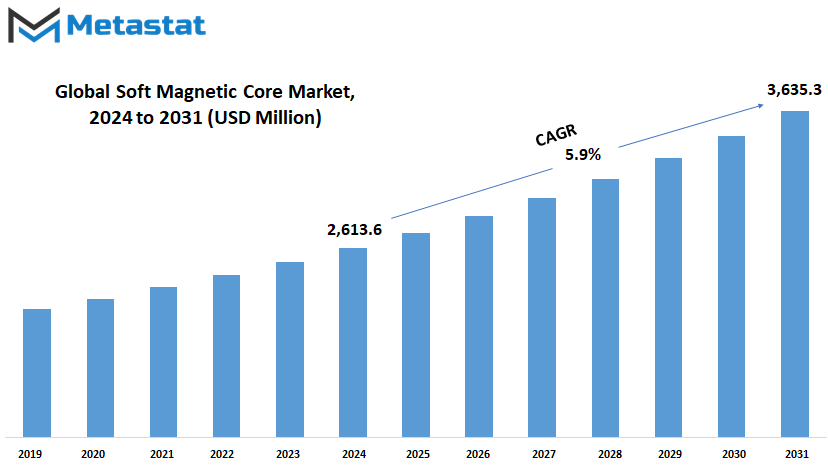
GROWTH FACTORS
The Global Soft Magnetic Core market is expected to grow majorly in the coming years due to several key factors. One of the most important factors behind this growth is that electric vehicles are being highly adopted, and high-performance magnetic components are quite essential in EVs. With more people and companies opting for EVs due to increased awareness and concern for their carbon footprint and eventually seeking cleaner energy sources, the demand for advanced magnetic materials that ensure efficiency in electric motors and transformers will rise. High-performance soft magnetic cores are of utmost importance in optimizing the performance of electric components used in electrical vehicles such as motors, charging stations, and others in power systems. This trend will continue as the global automotive industry accelerates its transition towards electric mobility.
The increasing adoption of renewable energy systems, like wind turbines and solar inverters, drives the Global Soft Magnetic Core market. More renewable energy sources are needed for residential and industrial purposes as countries strive to achieve sustainability goals. In particular, in wind turbines and solar power systems, efficient electrical systems are required to convert mechanical or solar energy into electricity.
Consequently, the effective working of generators and power converters in these renewable energy systems is critical for the use of soft magnetic materials. A larger-scale application of such systems is likely to demand more and more soft magnetic cores in ensuring the smooth running of electrical components in the production of renewable energy. Although there are bright positive signals, some factors would generate concerns for growth in this market.
One such barrier is high-end materials such as nanocrystalline and amorphous alloys, which are costly. Though the qualities possessed by such materials enhance performance in high-efficiency electrical systems, high production cost limits large-scale penetration. Other limiting factors in market growth would be the thermal stability of certain soft magnetic materials. The materials would not be optimized in high-temperature conditions in a number of applications and therefore applied sparingly in rigorous electrical systems. However, new generations of advanced soft magnetic materials, which are more compact, economical, and energy-efficient, would be the growth opportunity in the market. The further development of the technology, scientists and producers would focus on improving the soft magnetic core performance to meet the latest demands on compact systems from various industries.
These new items should help expand the market as it would encourage businesses to take advantage of the new demand for energy-efficient electrical systems. In the next few years, we can expect new materials to arrive with improvements in performance and cost-effectiveness, which will fuel further growth in the Global Soft Magnetic Core market.
MARKET SEGMENTATION
By Type
The Global Soft Magnetic Core market is expected to expand significantly over the next few years. This will be due to the rapid progress of technology and growing demand for energy-efficient solutions. Such materials have been crucial for use in the electronics industry as well as renewable energy sectors, given their ability to enhance magnetic performance while reducing energy losses. The importance of these cores becomes even more evident with industries looking towards better efficiency and sustainability.
The variety of core types is perhaps one of the most critical factors influencing this market, each of which offers unique advantages. Ferrite cores, for example, are used in the widest applications because they are affordable and have a high magnetic permeability. They are most often found in consumer electronics and power transformers. Amorphous cores, known for superior energy-saving properties, are also increasingly used in applications where efficiency is key.
Nano-crystalline cores have been gaining much attention with excellent magnetic properties and compact construction that are becoming increasingly important for high frequency applications such as modern communication systems and advanced power electronics. Permalloy cores with high magnetic saturation and low coercivity are mostly applied to sensitive applications, for instance, signal transformers and magnetic shields. On the other hand, silicon steel cores form the backbone of electrical machinery on account of their robustness and efficiency. And of course, the market also has other specialized cores for niche applications, but there is versatility in this technology.
The future ahead of the Global Soft Magnetic Core market looks bright as businesses continue to innovate and adapt toward changing demands. For instance, renewable energy sources such as wind and solar power depend significantly on such magnetic materials for energy storage and conversion. Similarly, the increasing trend of electric vehicles requires advanced cores to help improve motor performance and conserve energy, which makes these cores indispensable in the automobile industry.
Another driving force is the global push for miniaturization in electronics. As devices continue to shrink but become more powerful, manufacturers are increasingly turning to nano-crystalline and amorphous cores to meet these evolving requirements. More investment in research and development will bring even more efficient materials, paving the way for advancements that were considered futuristic.
The Global Soft Magnetic Core market will thrive as it aligns with the world’s focus on efficiency and sustainability. These cores will play a key role in shaping technologies of tomorrow as the applications continue to grow with innovation.
By Shape
The Global Soft Magnetic Core market will grow steadily with time because of its essential requirement in various industries, including automotive, electronics, and energy. Soft magnetic cores play a crucial role in making electrical devices more efficient through the reduction of energy loss. As demand increases for advanced technologies and renewable energy solutions, the requirement for soft magnetic cores has become one of the most momentous demands. The market is segmented on the basis of the shape of the core and includes Toroidal Core, E-Core, C-Core, Rod Core, U-Core, and others. Each of them caters to a unique application that contributes to the diversity and adaptability of the market.
Toroidal cores, which are known for compact and efficient design, find applications in transformers and inductors mainly in high-frequency applications. They offer excellent magnetic performance and are likely to remain popular because they can handle a higher power density with minimum electromagnetic interference. E-Cores are also versatile, and in most applications that require low energy loss, they are used in power supplies and electronic circuits. Their balanced properties ensure steady demand in both industrial and consumer sectors.
C-cores, on the other hand are designed for high efficiency transformer and power systems. Being easily assembled, makes this a popular option in many heavy-duty applications. The rod core is popular among small inductors as well as sensors that people use in compact electronic gadgets. Its flexibility means continued contributions to the market through its use as miniaturization becomes increasingly sought. U-Cores, as known for their structural simplicity, are used in applications demanding stable magnetic performance with straightforward designs. The “others” category, which has emerging shapes and innovations, suggests that the market has the potential to evolve and grow based on specific industrial needs.
In the Global Soft Magnetic Core market, future growth will benefit from advancements in material science and manufacturing techniques. Higher permeability and lower core loss are now high priorities in enhanced properties. Demand for these cores will be fueled by the growing electric vehicle and renewable energy systems, which play a significant role in energy conversion and storage solutions. The smart grids integration and further development of electronics also contribute to the growth of this market, ensuring its place in future technologies. Overall, the market trends align well with global standards on efficiency, sustainability, and technological advancement, putting it at the forefront in forming modern industry.
By Application
The Global Soft Magnetic Core market is picking up speed with advancements in technology shaping the future of energy-efficient and advanced electronic devices. Soft magnetic cores, comprising materials of high magnetic permeability and low coercivity, serve as crucial tools for the reduction of energy loss in various electrical and electronic applications. With performance improvement at the forefront, the consumption of soft magnetic cores is going to be increasingly on the rise.
By application, the expansion of the market cuts across various key areas such as transformers, motors, generators, inductors, magnetic sensors, and other electronic components. Transformers, for example, depend on soft magnetic cores for improved energy transfer efficiency especially in power distribution and renewable energy systems. With the increasing focus on clean energy and smart grids, the demand for advanced transformers is likely to increase, thereby influencing the demand for soft magnetic cores. Motors are a core part of automotive, industrial, and consumer electronics, and these cores optimize performance and reduce energy consumption. The push toward electric vehicles increases the focus on motors with efficient soft magnetic core technology.
In generators, transforming mechanical into electrical energy and providing higher efficiency with much less loss of power involves soft magnetic cores. Growth in the use of alternative sources like wind and sunlight, requiring generators, provides an evidence of this industry’s increasing importance. Moreover, to control current as well as voltage in various electronic circuits, inductors are considered to be impossible without these soft magnetic cores, because they are relied upon to provide efficient and predictable operation. This miniaturization with increasing power of electronics devices further enhances the demand for compact, high-performance inductors.
Magnetic sensors are important for applications that go from automotive safety systems to consumer electronics and rely on soft magnetic core properties for improvement in sensitivity and accuracy. Other electronic components such as power supplies and communication equipment also take advantage of developments in soft magnetic materials that provide better performance in several applications.
Future advancements in material science and manufacturing processes will be inclined to bring forth novel, innovative soft magnetic cores offering better capabilities. These advances together with the worldwide drive toward sustainability and energy efficiency will drive up the growth of the Global Soft Magnetic Core market, setting it as one of the cornerstones to be seen in the energy management and electronic innovation tomorrow. As such, it will continue to develop as technologies advance and mature with growing industries, setting the foundation for smarter and greener technologies.
By End-Use Industry
Rapidly developing technologies coupled with demands evolving across various sectors have significantly marked the future advancement of the global Soft Magnetic Core market. A soft magnetic core plays a vital role in electric devices and machineries with high magnetic permeability and minimal energy loss. Industries increasingly finding reliable energy-efficient and sustainable sources tend to raise the usage importance of such cores over time.
Demand in the electrical and electronics sector is due to their role to enhance energy efficiency. Soft magnetic cores are required in many transformers, inductors, and electric motors whose importance cannot be overlooked and are a basic requirement in modern electronic devices and systems. The shift of industries towards smaller, more energy-efficient devices has further made a need for innovative designs and materials in soft magnetic cores.
The automotive industry is another major contributor to the market’s expansion. Electric and hybrid vehicles, which are pivotal in the global move toward reducing carbon emissions, rely on soft magnetic cores for their motors and powertrains. As governments and organizations promote green energy initiatives, the market for electric vehicles is expected to grow, directly impacting the demand for these cores.
Energy and power generation is also a key factor that defines the market. Soft magnetic cores are widely used in renewable energy technologies, such as wind turbines and solar inverters, where energy efficiency and reliability are paramount. With the increasing shift from fossil fuels to renewable sources of energy, the demand for efficient energy conversion and storage will continue to fuel the market.
In telecommunications, the rising demand for faster and more reliable networks has called for advancements in infrastructure, in which soft magnetic cores play an indispensable role in the transmission and processing of signals. Similarly, in health care, they are also crucial in highly sophisticated imaging technologies, like MRI machines, which demand precise electromagnetic control for correct diagnostics.
The industrial machinery sector has advantages in automation and robotics, with soft magnetic cores facilitating accurate operations and better energy management. The aerospace and defense industries also use such cores for advanced electronic systems, where durability and performance are of utmost importance.
The Global Soft Magnetic Core market is poised to continue its growth in the future by virtue of continuous innovations and growing applications across different sectors of the economy. The general focus of the world today is on sustainable energy solutions, which is also fueling the adoption of renewable energy technologies, electric vehicles, and advanced telecommunications-ensuring relevance and further growth for the market in the modern industry.
|
Forecast Period |
2024-2031 |
|
Market Size in 2024 |
$2,613.6 million |
|
Market Size by 2031 |
$3,635.3 Million |
|
Growth Rate from 2024 to 2031 |
5.9% |
|
Base Year |
2022 |
|
Regions Covered |
North America, Europe, Asia-Pacific Green, South America, Middle East & Africa |
REGIONAL ANALYSIS
The Global Soft Magnetic Core market is poised for great growth across different regions, and each region has a unique contribution to the overall dynamics. North America consists of the U.S., Canada, and Mexico. The U.S. is likely to dominate because of its advanced technological infrastructure and heavy industrial base. Automotive, electronics, and renewable energy are the most emerging markets for soft magnetic cores. It is expected that the region will focus more on innovative and sustainable industrial practices and thus the demand will be on the rise.
Other important markets for soft magnetic cores include Europe. Important players in this market include the UK, Germany, France, and Italy. Germany is also expected to show significant growth in this market due to its manufacturing base. The increasing use of electric vehicles (EVs) and expansion of renewable energy sources, especially wind power, will increase demand for soft magnetic cores in the region. As the European Union continues to invest in green energy technologies and electrification, the need for efficient magnetic components will grow substantially.
The Asia-Pacific area, covering China, Japan, India, and South Korea, will probably have the highest market growth in future years. China and Japan, having been major powerhouses in technology and manufacture, already have huge industries that use soft magnetic cores, particularly in the auto and consumer electronics sectors. India, too, will push the growth of this industry with industrialization and developing renewable energy sources. With the embracing of electric mobility, renewable energy, and industrial automation in these countries, demand for high-quality soft magnetic cores is likely to increase rapidly.
South America, including Brazil and Argentina, constitutes a more emerging market for soft magnetic cores. Presently, the region is a little behind in comparison with North America or Asia-Pacific, but with the regional focus on infrastructure development as well as adoption of renewable energy technologies, the area is likely to grow even more in the future. Brazil is one of them, as the country is continuing to push projects in both wind and solar energy.
The Middle East & Africa, comprising the GCC countries, Egypt, and South Africa, represents a largely untapped region in the soft magnetic core market. While many of the countries in this region have traditionally not emphasized high-tech manufacturing, a lot of them are shifting their attention to modernizing their energy and industrial sectors. With investments in renewable energy projects and an increasing push for industrial development, the demand for soft magnetic cores will likely grow in the future. As these regions continue their diversification efforts, the market for these materials will expand, particularly in the energy and electronics sectors.
In short, the world market for soft magnetic cores is expected to develop with increasing technological development and the requirement for energy-efficient solutions. This will contribute to the development of the market in all regions.
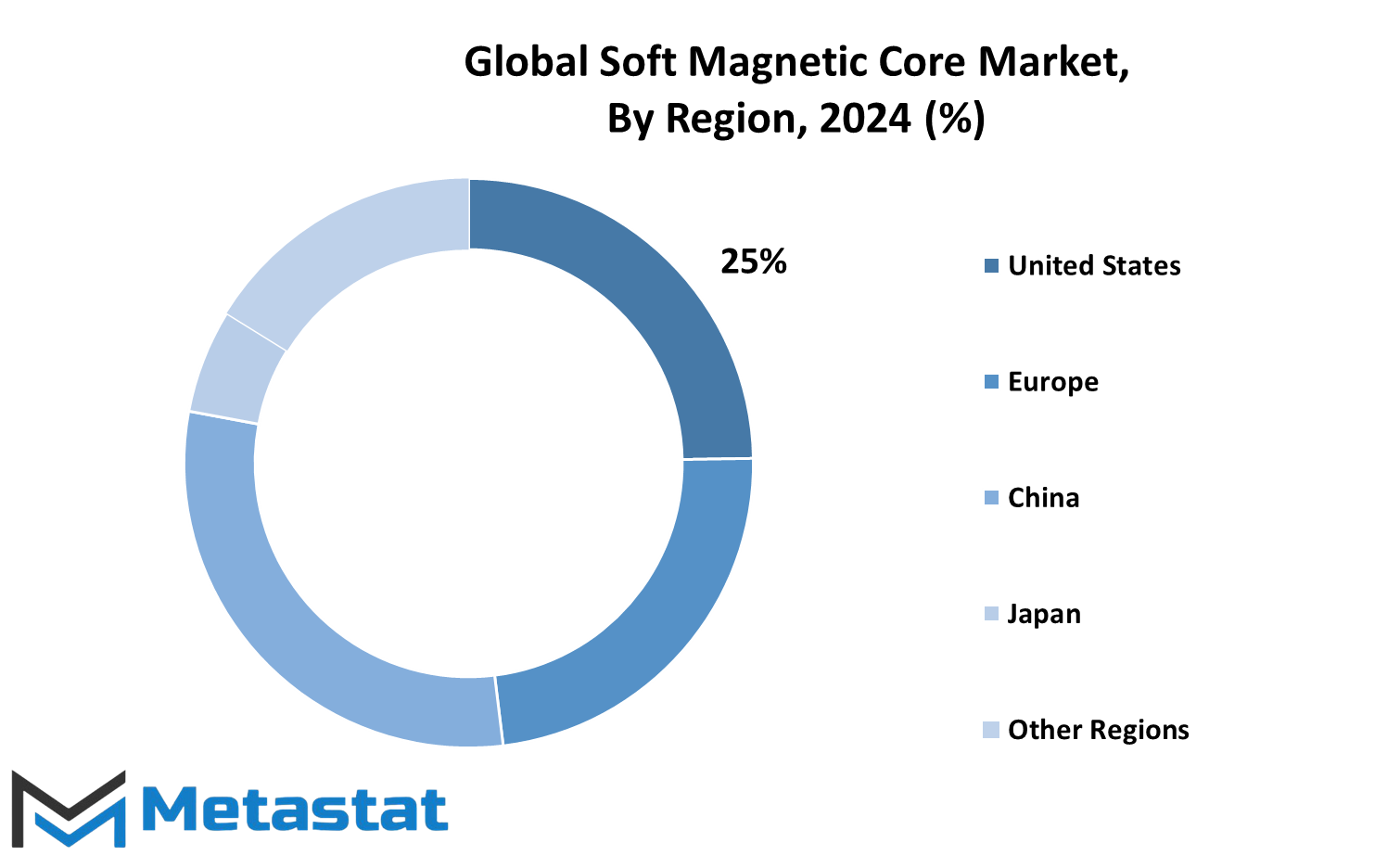
COMPETITIVE PLAYERS
The global market for soft magnetic cores is experiencing high development due to the growing need for advanced technological applications in various industries. Soft magnetic cores are a key component of electrical systems and are needed for the performance of a device like a transformer, electric motor, and an inductor. These cores are necessary because the materials from which they are made are ones that can easily magnetize and demagnetize once they encounter magnetic fields; hence they are highly efficient for electric devices. The market for soft magnetic cores is growing rapidly, primarily due to the requirement for more efficient, reliable, and energy-saving products fueled by technological advancements.
One of the major reasons driving the growth of this market is the increasing demand for electric vehicles (EVs), renewable energy sources, and consumer electronics. The products in these sectors necessitate high-performance soft magnetic cores to ensure that devices operate effectively and efficiently. For example, the adoption of electric vehicles calls for a stronger emphasis on high-performance magnetic cores capable of addressing their power and efficiency demands with electric motors. Soft magnetic cores are also in place for generators and inverters of renewable energy applications such as wind and solar power in order to harness energy without losing it with minimal loss.
The world market for soft magnetic core is very competitive, although there are several leading vendors that drive the market. Major companies include Hitachi Metals, Ltd., VACUUMSCHMELZE GmbH & Co. KG, and Toshiba Materials Co., Ltd., among others. These companies are prominent for their high research and development activities that focus on the production of more efficient and durable soft magnetic cores. In terms of innovations in material science, a lot will influence the future of this market with firms focusing on more resilient and efficient materials, operating at higher temperatures.
Other major players include Arnold Magnetic Technologies, Magnetics, Inc., and Sumitomo Metal Mining Co., Ltd., among others, as this industry is seeing much improvement from these key players. They are investing more in advanced manufacturing and production capacities to capture market shares as the demand for soft magnetic cores rises. More competition is also bound to arise in this industry, as companies seek their foothold in the vast market.
Trends expected to shape the global soft magnetic core market in the future include increasing focus on sustainability and environment. Companies are going to be focused on producing the magnetic cores from eco-friendly materials and with an environmentally friendly process. The continuous demand for more performance and miniaturized solutions will continue pushing the boundaries of innovation towards the development of new materials and technologies that improve the efficiency of soft magnetic cores. Key players will continue adapting and innovating to address increasing demands from industries across the globe.
Soft Magnetic Core Market Key Segments:
By Type
- Ferrite Core
- Amorphous Core
- Nano-crystalline Core
- Permalloy Core
- Silicon Steel Core
- Others
By Shape
- Toroidal Core
- E-Core
- C-Core
- Rod Core
- U-Core
- Others
By Application
- Transformers
- Motors
- Generators
- Inductors
- Magnetic Sensors
- Other Electronic Components
By End-Use Industry
- Electrical and Electronics
- Automotive
- Energy and Power
- Telecommunications
- Healthcare (e.g., MRI Machines)
- Industrial Machinery
- Aerospace and Defense
Key Global Soft Magnetic Core Industry Players
- Hitachi Metals, Ltd.
- VACUUMSCHMELZE GmbH & Co. KG
- Toshiba Materials Co., Ltd.
- Arnold Magnetic Technologies
- Magnetics, Inc.
- Sumitomo Metal Mining Co., Ltd.
- TDK Corporation
- GKN Powder Metallurgy
- Rio Tinto Group
- Höganäs AB
- SG Technologies Limited
- Advanced Technology & Materials Co., Ltd. (AT&M)
- AMES Group
- MMG Canada Limited
- Mate Co., Ltd.
WHAT REPORT PROVIDES
- Full in-depth analysis of the parent Industry
- Important changes in market and its dynamics
- Segmentation details of the market
- Former, on-going, and projected market analysis in terms of volume and value
- Assessment of niche industry developments
- Market share analysis
- Key strategies of major players
- Emerging segments and regional growth potential



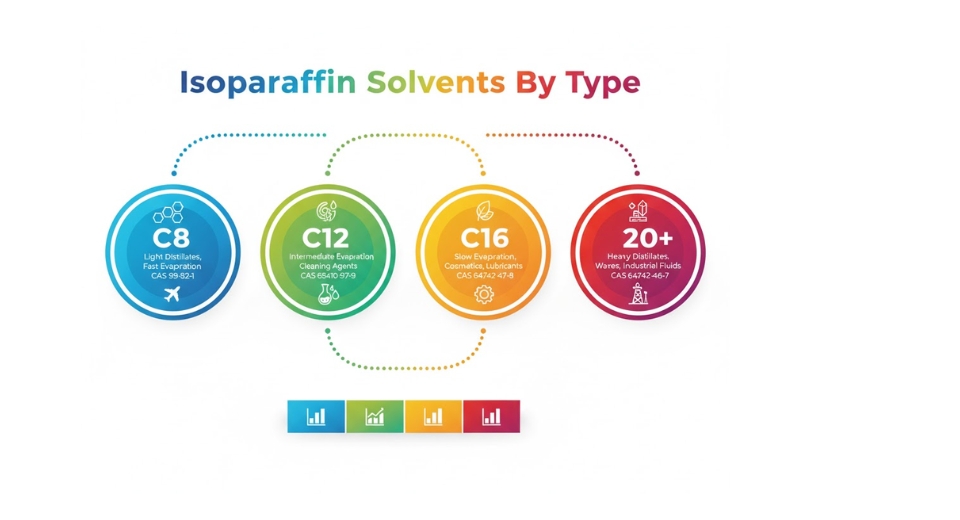
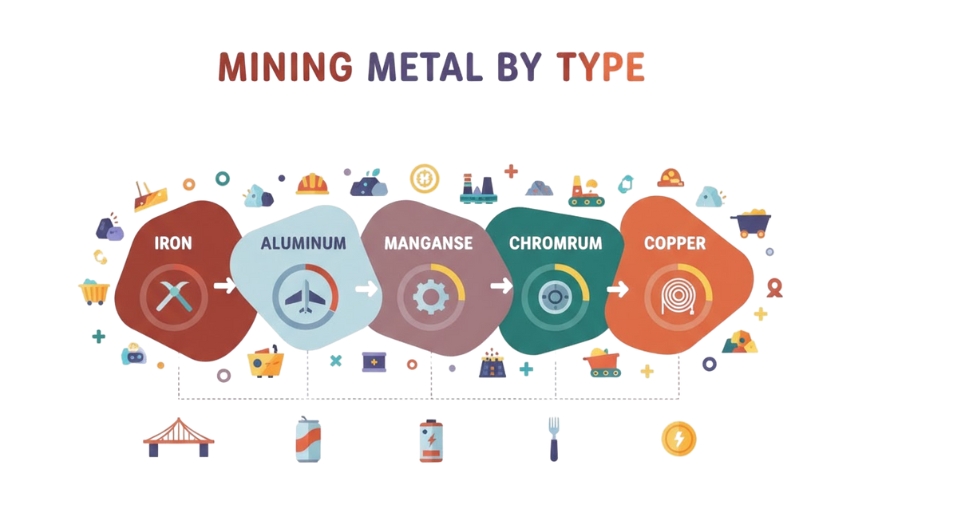
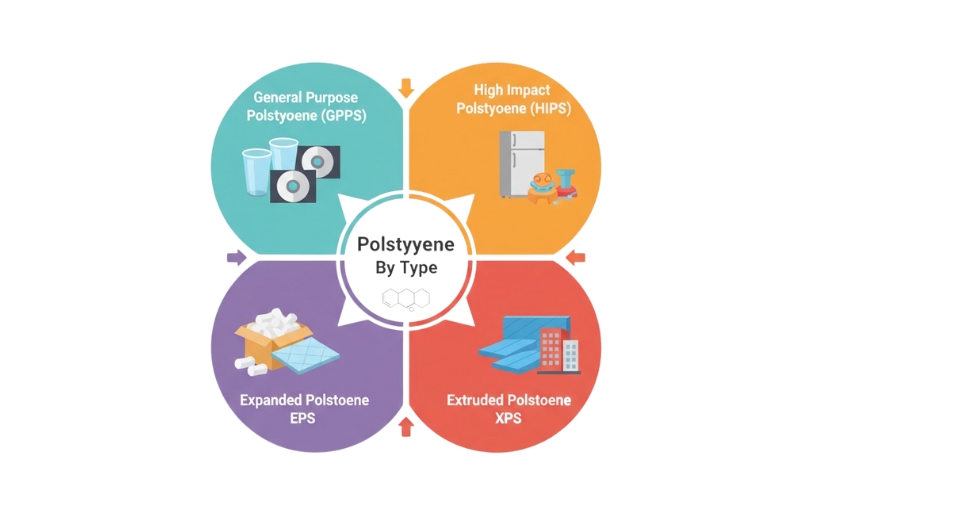

 US: +1 3023308252
US: +1 3023308252






